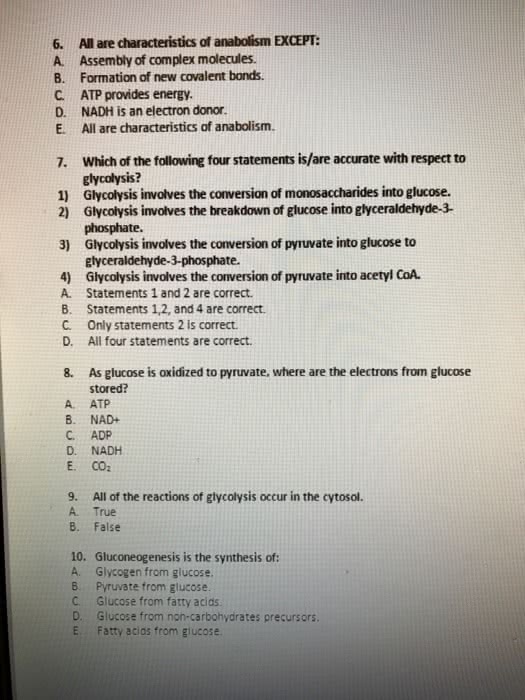Question 1 When energy changes from one form to another, some of the energy that can be used to do work is always lost. The loss of this energy is mostly in the form of _________.
a. heat
b. potential energy
c. kinetic energy
d. light energy
e. mechanical energy
Question 2 Which of the following is exergonic?
a. binding fatty acids and glycerol molecules together to form lipids
b. building proteins from amino acids
c. binding sugars molecules together to form glycogen
d. breaking bonds in starch to release glucose
e. adding a phosphate group to ADP to form ATP
Question 3 The first law of thermodynamics states that:
a. energy can neither be created nor destroyed.
b. the universe is increasing in entropy.
c. all living organisms must eat to derive energy.
d. energy is required to bring molecules into a cell against a concentration gradient.
e. in energy-yielding reactions, matter goes from a more-ordered to a less-ordered state.
Question 4 Which of the following is true of energy?
a. It can be transferred from one form to another with 100 percent efficiency.
b. It can be created.
c. It can be stored in chemical bonds.
d. It can never be stored.
e. It can be released by forming chemical bonds.
Question 5 Metabolism is:
a. the sum of all the energy a cell uses.
b. the sum of all the vitamins a cell contains.
c. the sum of all the enzymes a cell contains.
d. the sum of all the chemical reactions that an organism carries out.
e. the sum of all the ATP a cell contains.
Question 6 Entropy is the measure of ________ in a system.
a. disorder
b. order
c. energy
d. work
e. heat
Question 7 What percentage of the energy stored in glucose are humans cells able to use to do useful work?
a. 37%
b. 100%
c. 15%
d. 52%
e. 48%
Question 8 What is activation energy?
a. the energy gained by living things, allowing them to remain active
b. the energy produced by the breakdown of ATP to ADP.
c. the energy required to initiate or begin a chemical reaction
d. the energy created by enzymes during exergonic reactions
e. the energy lost by living things in the form of heat
Question 9 Which of the following is true of allosteric enzymes?
a. Their activity can be reduced when the product binds the enzyme.
b. Their activity can be reduced when a coenzyme binds to them.
c. Their activity can be reduced when the substrate binds the enzyme.
d. Their activity can be increased when the product binds the enzyme.
Question 10 Which of the following is a true statement about enzymes?
a. They are made of proteins.
b. They are altered by the reactions they catalyze.
c. They increase the energy of activation of chemical reactions.
d. All of the above are true.
e. None of the above is true.
Question 11 What is the energy currency of cells?
a. ADP
b. enzymes
c. glucose
d. vitamins
e. ATP
Question 12 Kinetic energy is ____________, while potential energy is _____________.
a. stored energy; energy that is being used
b. stored energy; energy that can't be used
c. energy that is being used; stored energy
d. energy that can't be used; stored energy
Question 13 The energy released during ________ reactions can be used to drive ________ reactions, and this is called ________ reactions.
a. exergonic; endergonic; coupled
b. endergonic; exergonic; coupled
c. exergonic; endergonic; mutually dependent
d. coupled; mutually dependent; independent
e. endergonic; exergonic; mutually dependent
Question 14 ADP + P + Energy --> ATP Which of the following is a true statement about the chemical reaction above?
a. This is a coupled reaction.
b. This is an exergonic reaction.
c. The product of the reaction contains more energy than that of all of the reactants combined.
d. This is an endergonic reaction.
e. This is an example of a catabolic reaction.




